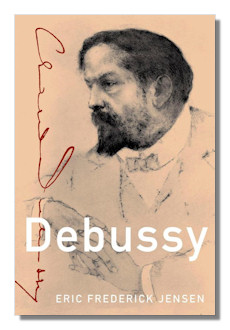
The Internet's Premier Classical Music Source
Related Links
-
Introduction
Acoustics
Ballet
Biographies
Chamber Music
Composers & Composition
Conducting
Criticism & Commentary
Discographies & CD Guides
Fiction
History
Humor
Illustrations & Photos
Instrumental
Lieder
Music Appreciation
Music Education
Music Industry
Music and the Mind
Opera
Orchestration
Reference Works
Scores
Thematic Indices
Theory & Analysis
Vocal Technique
Search Amazon
Recommended Links
Site News
 Book Review
Book Review
Debussy

Eric Frederick Jensen
Master Musicians Series
Oxford University Press (August 1, 2014)
Illustrations. 297 pages
Hardcover, alkaline paper
ISBN-10: 0199730059
ISBN-13: 978-0199730056
Jensen, the author of a volume on Schumann in this series, has now produced a concise but informative and insightful study of Debussy. The result is a clear picture of the man, his music, his mind, and his aesthetics. The study divides biographical and critical accounts in about equal proportion, but with his early life and career predominating in the biographical half. Included are accounts of both minor and important works.
As a man, Debussy does not come across as entirely admirable. The most unsavory example of this was his announcing, in 1894, when he was 32, his engagement to one woman before having terminated a longstanding relationship with another, which shocked his friends and damaged his reputation. The fiancée broke off the engagement, of course. Ironically, the engagement seems to have been an attempt to regularize the Bohemian life he was living in the thirteen years following his stay in Rome after winning the Prix de Rome. In 1900 he did marry, with Lilly Texier, but four years later he ran off with the wealthy Emma Bardac, the wife of a banker, occasioning a suicide attempt by Lilly. Paul Dukas reported that Debussy was being called a heartless, trifling egoist. This cost Debussy not only alimony but a great deal of indebtedness, through keeping up with Emma's lifestyle expectations.
Debussy became remote and hard to know; following the divorce, Zoltan Kodaly, who would have liked to meet him, was told that he was unapproachable. He did meet Richard Strauss over lunch. Strauss wanted to talk about the business side of music but Debussy's attention wandered instead.
Jenson provides information about a number of Debussy's friends and other associates whom he did know well. Among the more famous, Nadezhda von Meck, well-known as Tchaikovsky's patron, also assisted Debussy. The former was not permitted to meet her, but Debussy spent time with her and family on three occasions – in several countries – from the age of eighteen. Later, Erik Satie was found to be a kindred spirit, both sharing a disain for conventionality; they met at least weekly for a quarter of a century. A friendship with Paul Dukas declined with the divorce scandal but later they became "amicable once again." Vincent d'Indy admired Debussy's music, and the two respected one another. The partisans of both Dukas and d'Indy created some antagonism to Debussy's music, however. Massenet and Chausson also play parts in Debussy's story.
Debussy was very interested, from a young age, in the visual arts (he had talent as an artist) and in literature, especially the literary symbolists. He wrote songs with texts by Verlaine and Mallarmé (who was pleased with the results in Prelude to the Afternoon of a Faun). For his opera Pelleas et Melisande, Debussy's libretto used the words of Maeterlinck. It took him a long time to get around to writing an opera, something that recipients of the Prix de Rome were expected to produce right away, in order to consolidate their careers. Debussy took his time because he was not at all ready, and because he did not want to write one in a traditional style. He did not wish to write anything in a traditional style, in fact. What is more, he did not wish to repeat himself and he did not want imitators.
Jensen considers the application of the term impressionism to Debussy's music. Initially it was not intended as a compliment, and it was never meaningfully well-defined. But it stuck as a label. Debussy's friend and biographer Louis Laloy said that such music was "purely auditory, just as Impresionist painting is purely visual." Louise Libich in 1908 said that Debussy used and blended sounds like colors, and that his "beautiful harmonies, seemingly woven of refracted rays of light, merge into infinite melody, of a free, flowing rhythm.,, His own art and that of painting are in some instances almost identical in method." Edward Dent in 1924 spoke of fragmentary melodic lines, and "slow harmonies which an older generation would have regarded as discords, but which the present day regards as agreeable consonances," and "a general effect of timbre rather than a clearly intelligible succession of notes." Jensen notes that Debussy's harmonies were nonfunctional, suggesting a comparison with the Impressionists' emphasis on color.
About Debussy's melodic style, Jensen characterizes it in several places as arabesque, which Debussy found also in the music of Bach. Much about Debussy's aesthetics was expressed in personal letters. Music was not supposed to make people think, but rather to "listen, in spite of themselves," and to be transported imaginatively to a dreamlike state. Here was a specific connection to Symbolism. Debussy particularly rejected classical traditions including sonata form, especially development. "Debussy's compositional approach was determined by what pleased the ear, not by rules…. 'Well-made' structures were 'architecture, not music.'" Jensen says that "it is helpful from the start to think of Debussy's music simply as sonority – and to take his musical basis (color and rhythm) as a point of departure." His "melody and harmony seem uniquely integrated." It "infuriated" Debussy when critics complained that melody was absent from his music.
Highly recommended.
Copyright © 2014, R. James Tobin



















